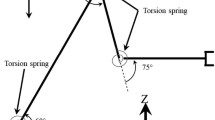Abstract
Special Session: Multibody systems and mechanism design in robotics. This article aims to provide a didactic approach to energy-based dynamic modeling. Understanding these concepts is essential to grasping classical physics and mechanics. However, they can be challenging for science and engineering students, especially for those in the early stages of their studies, due to the technical terminology and jargon used in these fields. This article aims to offer a simple and didactic approach to help students better understand these fundamental concepts. Specifically, the article demonstrates how the principle of least action underlies all energy-based formalisms and how it can be used to model dynamic systems using easy-to-follow examples. This manuscript presents didactic and teaching contributions. It targets undergraduate students who are interested in addressing topics of dynamic modeling of robots and other more elaborate mechanical systems. It is also focused on those who need to have a solid foundation in the physical formalisms that assist in dynamic modeling projects and associated disciplines.
Access this chapter
Tax calculation will be finalised at checkout
Purchases are for personal use only
Similar content being viewed by others
References
Stone, M.: The Principle of Least Action, 2nd edn. Dover Publications, New York (2012)
Stone, M.: The principle of least action. Am. J. Phys. 70(8), 791–797 (2002)
Feynman, R.P., Leighton, R.B., Sands, M.: The feynman lectures on physics, vol. II: the new millennium edition: mainly electromagnetism and matter. Am. J. Phys. 79(8), 880–881 (2011)
Greenwood, D.T.: Classical Dynamics. Cambridge University Press (2017)
Thornton, S.T., Marion, J.B.: Classical Dynamics of Particles and Systems. Cengage Learning (2004)
Tsai, L.W.: Robot Analysis: The Mechanics of Serial and Parallel Manipulators. Wiley, New York (1999)
Sastry, S., Agarwal, R.K.: Calculus of Variations with Applications. Springer, Berlin (2019)
Serrano, J.L.G., Martínez, E.J.S.: Application of Euler-Lagrange equations in mechanical systems. Arch. Comput. Methods Eng. 25(2), 427–442 (2018)
Marrero, J.C., Martín de Diego, D., Muñoz-Lecanda, M.C.: Hamiltonian dynamics and symmetries. J. Phys. A: Math. Theor. 53(30), 303001 (2020)
Faddeev, L.D., Jackiw, R.: Hamiltonian reduction of unconstrained and constrained systems. Phys. Rev. Lett. 60(17), 1692–1694 (1988)
Craig, J.J.: Introduction to Robotics: Mechanics and Control. 3rd edn. Pearson Education, Upper Saddle River, New Jersey (2004)
Niku, S.B.: Introduction to Robotics: Analysis, Control, Applications, 2nd edn. Wiley, Hoboken, New Jersey (2010)
Author information
Authors and Affiliations
Corresponding author
Editor information
Editors and Affiliations
Rights and permissions
Copyright information
© 2024 The Author(s), under exclusive license to Springer Nature Switzerland AG
About this paper
Cite this paper
Saldias, C.E.P., Saldias, D.A.P. (2024). A Didactic Approach to Energy-Based Dynamic Modeling: Least Action, D’Alembert Principle and Euler-Lagrange Formalism. In: Youssef, E.S.E., Tokhi, M.O., Silva, M.F., Rincon, L.M. (eds) Synergetic Cooperation Between Robots and Humans. CLAWAR 2023. Lecture Notes in Networks and Systems, vol 810. Springer, Cham. https://doi.org/10.1007/978-3-031-47269-5_11
Download citation
DOI: https://doi.org/10.1007/978-3-031-47269-5_11
Published:
Publisher Name: Springer, Cham
Print ISBN: 978-3-031-47268-8
Online ISBN: 978-3-031-47269-5
eBook Packages: Intelligent Technologies and RoboticsIntelligent Technologies and Robotics (R0)




